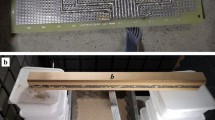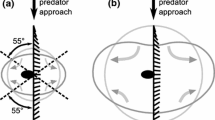Summary
-
1.
Simulation of wave signals by calculated phase-shifting of locally restricted, alternating magnetic fields which affected iron filings glued to claws of front- and middlelegs of Notonecta induced the animals to perform prey localization behaviour.
-
2.
Simulation of wave signals approaching at 20 and 30 degree angle to the animals longitudinal axis evoked turning reactions in size well matching the program of simulation (α = 20 °:xα′ = 19,2 °;n = 49;s = 5,5 °; α = 30 °:xxα′ = 30,8 °;n = 78;s = 8,5 °). The localization errors under these conditions were similar to those obtained after natural stimuli.
-
3.
Stimulation of the front legs exclusively evoked localization turns which are far more inaccurate than turns induced only by the mesothoracic legs (FL: α = 30 °:xα′ = 33,2 °;n = 37;s =11,2 °; ML: α = 30 °: xα′ = 30,3 °;n = 48;s = 5,8 °).
-
4.
The phenomenon of dispersion observed in water surface waves results in differencies of stimulus phase pattern depending on the frequency content of the wave signal. These differencies however are smaller than the generally shown localization errors and have therefore no maior influence on this system of orientation.
-
5.
The experiments suggest that stimulus phase control in each sense organ of the 4–6 receptor system is the basic principle of the highly accurate orientation ofNotonecta in the frontal range.
Similar content being viewed by others
References
Markl, H.: Leistungen des Vibrationssinnes bei wirbellosen Tieren. Fortschr. Zool.21, 100–116 (1973)
Markl, H., Lang, H., Wiese, K.: Die Genauigkeit der Ortung eines Wellenzentrums durch, den RückenschwimmerNotonecta glauca. J. comp. Physiol.86, 359–364 (1973)
Markl, H., Wiese, K.: Die Empfindlichkeit des RückenschwimmersNotonecta glauca L. für Oberflächenwellen des Wassers. Z. vergl. Physiol.62, 413–420 (1969)
Murphey, R. K.: Mutual inhibition and the organization of a non-visual orientation inNotonecta. J. comp. Physiol.84, 31–40 (1973)
Murphey, R. K., Mendenhall, B.: Localization of receptors controlling orientation to prey by the back-swimmerNotonecta undulata. J. comp. Physiol.84, 19–30 (1973)
Reinig, H. J., Uhlemann, H.: Über das Ortungsvermögen des TaumelkäfersGyrinus substriatus Steph. J. comp. Physiol.84, 281–298 (1973)
Wiese, K.: Das mechanorezeptorische Beuteortungssystem vonNotonecta. I. Die Funktion des tarsalen Scolopidialorgans. J. comp. Physiol.78, 83–102 (1972)
Author information
Authors and Affiliations
Additional information
Supported by DFG Az. 741,29 and Wi 363/1.
Rights and permissions
About this article
Cite this article
Wiese, K. The mechanoreceptive system of prey localization inNotonecta . J. Comp. Physiol. 92, 317–325 (1974). https://doi.org/10.1007/BF00696618
Received:
Issue Date:
DOI: https://doi.org/10.1007/BF00696618




